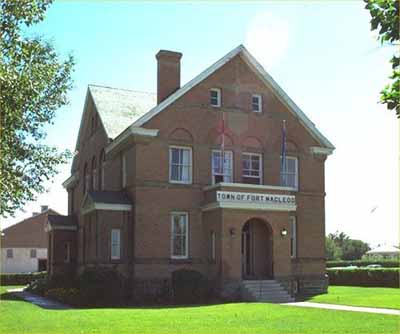Territorial Court House National Historic Site of Canada
Fort MacLeod, Alberta

General view
(© Parks Canada Agency/ Agence Parcs Canada, 1987.)
Address :
234 23rd Street, Fort MacLeod, Alberta
Recognition Statute:
Historic Sites and Monuments Act (R.S.C., 1985, c. H-4)
Designation Date:
1981-01-15
Dates:
-
1902 to 1904
(Construction)
-
1904 to 1971
(Significant)
Event, Person, Organization:
-
Department of Public Works
(Architect)
-
D. Ewart
(Architect)
-
Patrick Navin
(Builder)
Other Name(s):
-
Territorial Court House
(Designation Name)
-
Former Fort Macleod Court House
(Other Name)
Research Report Number:
COURT HOUSE - 1980
Plaque(s)
Existing plaque: On the grounds of the town office 234 23rd Street, Fort MacLeod, Alberta
Between 1888 and 1905, the Government of Canada built a dozen court houses to serve the new settlements on the prairies. Most of these buildings were phased out of service and eventually demolished following the implementation of Provincial Court systems in Saskatchewan and Alberta in 1907. The Fort MacLeod Court House was an exception. Completed in 1904 as a Territorial court house, it remained in service until 1971. It is the oldest court house in Alberta and one of the few buildings surviving from the period of Territorial administration on the prairies.
Description of Historic Place
The Territorial Court House National Historic Site of Canada is situated in Fort Macleod in southern Alberta. Built of red brick and trimmed with sandstone, the former court house is a two-and-a-half-storey building of domestic appearance with a rectangular footprint. The cross-gabled design features large, arched windows, returned eaves and projecting porches. Although the building has been converted to house the town’s municipal offices, the interior still retains some of the original features and finishes. Official recognition refers to the building on its lot.
Heritage Value
The Territorial Court House was designated a national historic site of Canada in 1980 because: it is representative of the judicial institution in Alberta; it is the oldest court house in Alberta and one of the few buildings surviving from the period of Territorial administration on the prairies.
The Territorial Court House served as the seat of justice for southern Alberta for 67 years. Between 1888 and 1905 the Government of Canada built a dozen court houses to serve the new settlements of the prairies. Most of these buildings were phased out of service and eventually demolished following the implementation of provincial court systems in Saskatchewan and Alberta in 1907, but the Court House at Fort McLeod was an exception. Completed in 1904 as a territorial court house, it remained in use until 1971. The Territorial Court House was one of three constructed from a standard plan produced by the federal Department of Public Works under the direction of Chief Architect D. Ewart.
Source: Historic Sites and Monuments Board of Canada, Minutes, November 1981.
Character-Defining Elements
Key elements that contribute to the heritage character of this site include: the prominent location in downtown Fort Macleod; the rectangular, two-and-a-half-storey massing set under a cross-gable roof; the construction of brick trimmed with sandstone, on a stone foundation; the balanced placement of doors and windows with the central entry protected by a porch approached by a flight of steps; the exterior detailing including the blind arches, stone window sills, pronounced stringcourses, returned eaves, and symmetrical arrangement of round and flat-headed windows; the surviving features and finishes which reflect the period of use as a territorial court house facility between 1904 and 1971; evidence of its original functional interior plan and spatial organization, notably the former courtroom, the cell and vault in the basement, and the wooden floors, stairs and wainscoting.